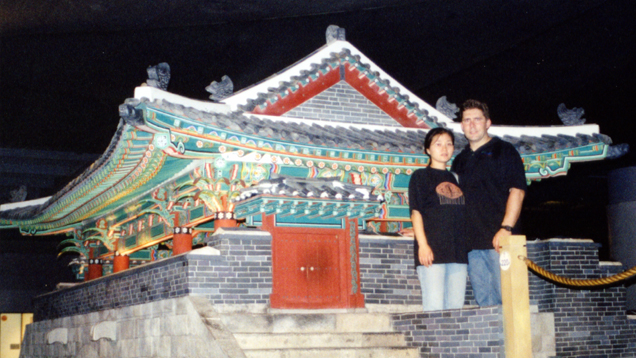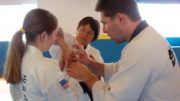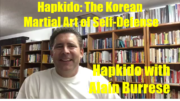It’s not unusual to set a little money aside to attend a martial arts camp or seminar. The summer before law school, I did one better. I traveled to South Korea for intensive hapkido training. In the process, I had a lot of fun.
This wasn’t the first time I’d been to Korea. I had previously lived in Kangnung. I trained in hapkido and ki gong (breathing exercises) and earned a black belt from the Korean Hapkido Federation. I traned at the Hapkido Choiyukwan under Young-Jong Kim and Jun-Kyu Lee. While I was living there, I taught English at a hogwan (private academy). Korean students attend these academies after their regular public school classes to get ahead with their studies. This time I wasn’t there to teach, however. I was there mainly to train.
When I arrived in Kangnung, I planned on spending the month living in one of the yokwans (cheap hotel) that are so abundant throughout Korea. However, Lee would have none of that. He and his family lived in and ran a minbak (an inn) near the beach. He insisted that I stay in one of the rooms without paying. Not only did I train with my instructor, be we did everything together, including going to the beach and movies.
4 Classes Per Day
When I first arrived, we had class four times a day. The first class was at 6 a.m. The following classes were at 2:30 p.m., 4:30 p.m., and 8 p.m. The times changed during summer vacation. The first class was bumped back to 9 a.m., followed by classes at 3, 5 and 8 p.m. Either way, I had four classes per day plus plenty of extra training between classes.
Typically, I’d go to class in the morning and then go back to Lee’s home to rest before the next session. After lunch, we would leave early so we could pick up some of the other students for the next class. This is common practice throughout Korea. Whether it is a martial arts school or something similar, a driver would pick up the other students in a minivan and drop them off afterward. We did this for every class. After the third class of the day, we would go home t eat dinner and practice various techniques before we went to the last class of the day. This was usually the longest and most intense class of the day because it consisted mainly of adults. It was usually 10 p.m. before we had the school swept, the water bottles filled and were ready to go home. By the end of class, our uniforms were soaked and we were spent. In these classes, we spent a lot of time sparring. Believe me, I went home sore on more than one occasion.
Generate Power
The type of training I did depended on the class. The early classes had younger students, so I often helped with the instruction. There were also several new students, so I usually worked on the basics with them. This was particularly enjoyable. It’s not only a way to better yourself, but the kids were great to work with, too.
Regardless of what class we were in, Lee always made sure that he taught me at least one new technique. This meant that I was learning between four and six new techniques per day. After class, I’d write the new techniques in a notebook along with the other notes from class. Each night, I’d review everything I learned that day before I went to sleep. The next day, I’d practice everything I had learned before he taught me something new.
Wednesday’s class was always different because we always worked with weapons. although we primarily worked with the staff or short stick, we sometimes worked with the bamboo sword. During the free time between classes, Lee also worked with me on various cane and belt techniques.
Besides all of the traditional hapkido I was learning, I also received an added bonus. Kim was teaching and working with Lee and a few of the other high-ranking students some striking methods called kwon sul. These drills involved a variety of strikes, including punches, ridgehands, spearhands, backfists and others. The key to these drills is shifting your body weight to gain the maximum power for your strike. It was always amazing to see how much power my instructor could generate with the slightest motion. Naturally, I jotted notes about his technique into my book every night.
Hapkido and Taekwondo
While the weekdays were reserved for hapkido, the weekends were for rest and relaxation. I spent those summer weekends visiting new places with my fiancee, Yi Saeng Ham, going out with friends and resting from the week’s grueling schedule. Like all vacations, the time flew by much too quickly. Before I knew it, I had to return to the States.
I realize that not everyone has connections to go to Korea to live with an instructor. However, there are many opportunities for people to visit Korea and train in various arts, including hapkido, taekwondo, and other arts. I encourage anyone to visit and train in Korea. Without a doubt, it will be an experience you will always remember.
(This was originally written for Karate Kung Fu Illustrated and appeared in the August 1999 issue. Since that time, I’ve made many more trips back to visit my instructors and will make many more.)






Be the first to comment on "A Summer in Korea"